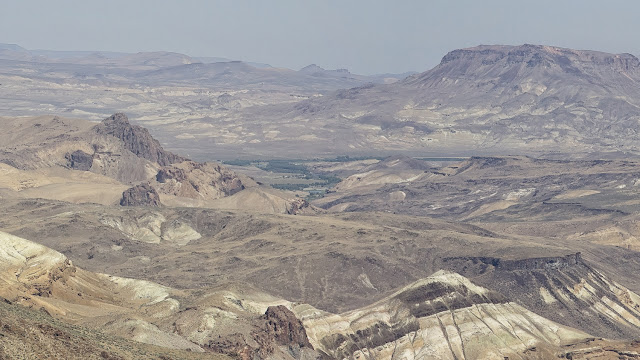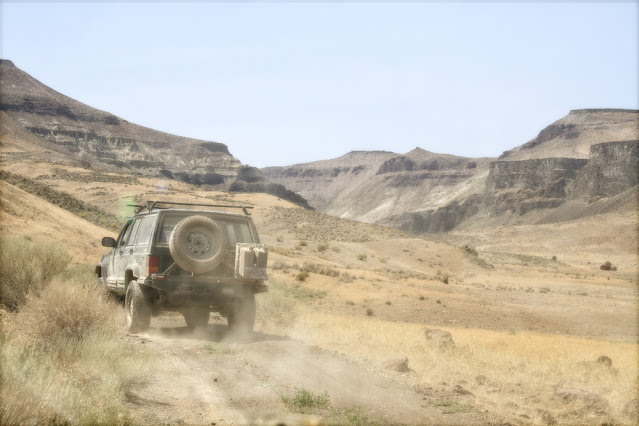Once again we are approaching the edge of the canyon and once again we will be required to survey our resources and evaluate our prospects. Not having a vehicle, I’m not troubled much with these decisions beyond figuring out which driver is liable to kill me the most and lobbying to ride with the one who won’t. Fortunately, we’ve ridden rapids on wilderness rivers together, negotiated powerful tidal currents together, and together even stood at the edge of Rico’s conspicuously excessive campfires.Maybe all of this has simply fostered a false sense of security, but it might also be interpreted as a history of shared experiences that lead to trust.
Somewhere down there is our campsite. At this point, I feel it is important to add that this picture could have, besides expressing the drama of at least two adventurers facing their unknown futures, easily also been a marvelous advertisement for Pabst Blue Ribbon Beer (Want to sponsor us? Leave a note in the comments). We all drink it, and some of us drink it exclusively (We’re talking about you, water!). Just what do you think Rico and Kip have in their hands right now?
Imagine product placement like this…
Or this (see what we’ve done there? It says Drive Slowly and Enjoy BeEr!).
The path before us surrenders more and more of its area to encroaching vegetation and the grade becomes more pronounced.
But finally we begin to catch glimpses of the Owyhee River.
In a parched land, the shimmering, pulsing artery of blue and green is unmistakable, bringing the possibility of life to this vast landscape.
As the path grows narrower and as it begins to trace switchbacks into the hills in its effort to dip to the valley floor, we become aware that in places, we may find it difficult or impossible to turn around - that is, once we begin our decent, we may be forced to proceed forward unless, as a driver, you can tackle complicated off-road bits going backwards. So perched on the edge of Yoda’s proverbial, “...do or do not.” Rico elects to reconnoiter the route ahead on foot.
To me, the route looks kind of crazy. It straddles the pointy edge of a ridge that makes it look like Kip and Rico will be driving on the cutting edge of the curved blade of a scimitar.
And this I suppose, is the reason we go on these camping trips. Up until this point, you could say we’ve been on vacation. We’ve been on a guided tour. We’ve visited spots along the way, like you do on the way to Disneyland. But now, just maybe, there’s a chance that this can all turn into an adventure. We don’t know exactly where we will camp. We don’t know exactly how or if we’ll get there. We’ve found a place to step into the unknown - a place where we can take calculated risks and the results will depend on the quality of our decisions and our skills.
Now, instead of the mediators our culture has devised to serve as a safety net, we will be dealing more directly with the Earth. Granted, we aren’t exactly adrenaline junkies, but I feel it is correct to say that finding that primal connection - fitting more closely into the Eco-system - slipping back into the food chain - somehow it feeds latent appetites.
Our day-to-day media-rich environment is saturated with memes that implore us to “Boldly go where no one has gone before” or “...take the road less traveled”, or “Don’t follow any path at all…but make a trail”. Cinema, literature, music, they all have substantial road-trip genres. Even our earliest stories, our scriptures and our myths tell of adventurers and quests and God imploring patriarchs to step into unknown futures.
“...Mellow is the man who knows what he’s been missing
Many, many men can’t see the open road…”
- Led Zeppelin
If all goes well, we assume we’ll soon be passing by that lone shrub down below.
It seems the Owyhee has meandered back and forth across the wide valley floor for a very long time. The place it has settled in for now is far away from the picturesque canyon walls. The river wears a delicate necklace of grasses and shrubs and opportunistic trees. We find a small stand of trees with healthy canopies and set up camp.
Up river, the road terminates in an abandoned ranch. The canyon stretches around a bend and on out of sight.
Tall grasses grow along the river and hide its banks in shade…
 |
| Photo Credit: Rico |
…and Uncle Rico quickly sets about filling up his stringer.
 |
| Photo Credit: Kip |
For a change, I try to remember how to clean fish without asking Rico again.
Kip and Rico have already begun setting up the kitchen.
Rico deep fries the batter-dipped small-mouth bass.
Kip acts as bartender.
 |
| Fish Taco (One species, two if you count avocado as a species) |
 |
| Now that we are in the canyon, the temperature at night is much warmer. Even so, the increase in insects spurs Kip to break out his tent. |
 |
| Deb catches the four Galilean Moons careening around Jupiter |
...to be continued...
PART 4: Hawaii, Owyhee...uh, Boglands (Part Four)
Have you missed any previous installments?
PART 1: Hawaii, Owyhee...uh, Boglands (Part One)



























No comments:
Post a Comment